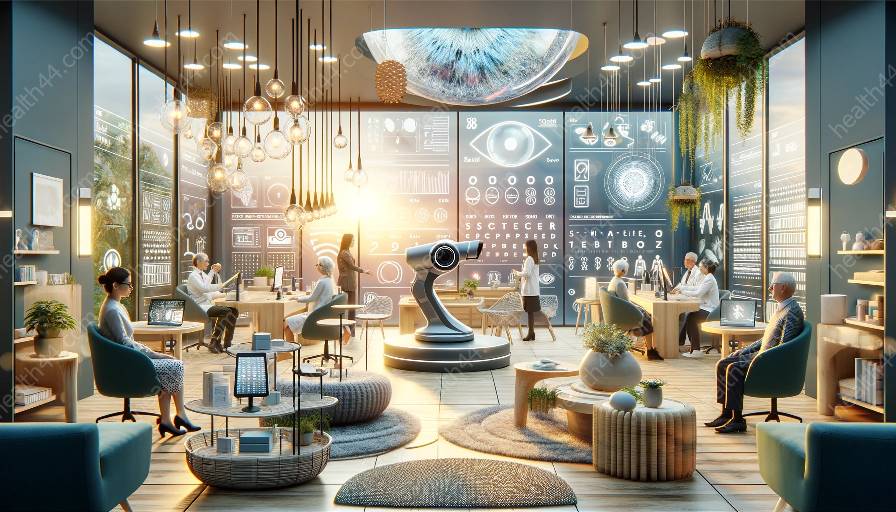Assistive technology is of great importance in vision rehabilitation, enabling individuals with visual impairments to lead more independent lives. This article delves into the role that human-computer interaction plays in the design and enhancement of assistive technology for vision rehabilitation.
Understanding Assistive Technology and Vision Rehabilitation
Assistive technology refers to devices, equipment, or systems that are specifically designed to improve the functional capabilities of individuals with disabilities. Vision rehabilitation, on the other hand, encompasses a range of therapeutic approaches and interventions aimed at helping individuals with vision loss or impairment to maximize their remaining vision and adapt to their condition.
The Significance of Human-Computer Interaction
Human-computer interaction (HCI) is a multidisciplinary field that focuses on the design, implementation, and evaluation of interactive systems and the ways in which users interact with technology. In the context of assistive technology for vision rehabilitation, HCI plays a crucial role in understanding the needs, limitations, and preferences of users with visual impairments, and in designing user-friendly and efficient solutions.
Addressing User Needs
The foundation of HCI lies in user-centered design, which involves actively involving end-users in the design process to ensure that the resulting technology meets their needs and aligns with their abilities. When it comes to vision rehabilitation, HCI enables designers to gain insights into the specific challenges faced by individuals with visual impairments and to develop assistive technologies that address these challenges effectively.
Enhancing Accessibility and Usability
Through the principles of HCI, assistive technology for vision rehabilitation can be designed to be more accessible and user-friendly. This includes considerations such as the use of tactile interfaces, voice-activated controls, screen magnification, and speech output, all of which are aimed at enhancing the usability of the technology for individuals with visual impairments.
Incorporating Innovation
Advancements in HCI have led to innovative solutions in assistive technology for vision rehabilitation. For example, the integration of gesture recognition, haptic feedback, and artificial intelligence has resulted in more intuitive and interactive systems that cater to the unique needs of individuals with visual impairments.
Benefits of Human-Computer Interaction in Vision Rehabilitation
The impact of HCI on the design of assistive technology for vision rehabilitation is far-reaching, offering several benefits to users and the broader healthcare community.
Empowerment and Independence
By leveraging HCI principles, assistive technology can empower individuals with visual impairments to perform daily tasks independently, thus promoting greater independence and autonomy in their lives. This can significantly improve their quality of life and reduce their reliance on assistance from others.
Personalized Solutions
HCI allows for the customization and personalization of assistive technology to better suit the unique needs and preferences of individual users. This personalized approach enhances the overall effectiveness and usability of the technology, leading to more positive outcomes in vision rehabilitation.
Improved Healthcare Delivery
Through HCI-driven design, assistive technology for vision rehabilitation can contribute to improved healthcare delivery by streamlining processes, reducing errors, and enhancing communication between individuals with visual impairments and their healthcare providers. This, in turn, can lead to more efficient and effective rehabilitation outcomes.
Future Directions
Looking ahead, the role of human-computer interaction in the design of assistive technology for vision rehabilitation is poised to evolve further as technology continues to advance. Virtual and augmented reality, biofeedback systems, and smart wearables are among the emerging technologies that hold tremendous promise in enhancing the rehabilitation experience for individuals with visual impairments.
Collaboration and Research
Collaboration between HCI experts, assistive technology developers, healthcare professionals, and individuals with visual impairments will be vital in driving the ongoing development and refinement of vision rehabilitation technologies. Furthermore, continued research in HCI and its applications to vision rehabilitation will fuel the innovation and evolution of these technologies.
Conclusion
Human-computer interaction serves as a cornerstone in the design and advancement of assistive technology for vision rehabilitation, enriching the lives of individuals with visual impairments and fostering a more inclusive and accessible society. By leveraging the principles of HCI, designers and developers can create innovative and user-centric solutions that have a transformative impact on vision rehabilitation and the overall well-being of those with visual impairments.





















